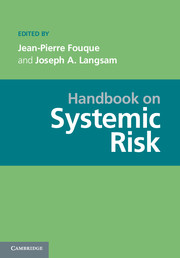Book contents
- Frontmatter
- Contents
- Contributors
- Introduction
- PART I DATA: THE PREREQUISITE FOR MANAGING SYSTEMIC RISK
- PART II STATISTICS AND SYSTEMIC RISK
- PART III MEASURING AND REGULATING SYSTEMIC RISK
- PART IV NETWORKS
- PART V SYSTEMIC RISK ANDMATHEMATICAL FINANCE
- PART VI COUNTERPARTY RISK AND SYSTEMIC RISK
- PART VII ALGORITHMIC TRADING
- PART VIII BEHAVIORAL FINANCE: THE PSYCHOLOGICAL DIMENSION OF SYSTEMIC RISK
- PART IX REGULATION
- PART X COMPUTATIONAL ISSUES AND REQUIREMENTS
- PART XI ACCOUNTING ISSUES
PART X - COMPUTATIONAL ISSUES AND REQUIREMENTS
Published online by Cambridge University Press: 05 June 2013
- Frontmatter
- Contents
- Contributors
- Introduction
- PART I DATA: THE PREREQUISITE FOR MANAGING SYSTEMIC RISK
- PART II STATISTICS AND SYSTEMIC RISK
- PART III MEASURING AND REGULATING SYSTEMIC RISK
- PART IV NETWORKS
- PART V SYSTEMIC RISK ANDMATHEMATICAL FINANCE
- PART VI COUNTERPARTY RISK AND SYSTEMIC RISK
- PART VII ALGORITHMIC TRADING
- PART VIII BEHAVIORAL FINANCE: THE PSYCHOLOGICAL DIMENSION OF SYSTEMIC RISK
- PART IX REGULATION
- PART X COMPUTATIONAL ISSUES AND REQUIREMENTS
- PART XI ACCOUNTING ISSUES
Summary
Computational Issues and Requirements: Introduction
While the computational and security considerations to properly address systemic risk in the financial sector are still emerging, it is already very evident that they will be extremely challenging in multiple dimensions. This Part addresses this problem from three different perspectives.
In the first chapter, Enabling Data Analysis for Addressing Systemic Risk, Eric Hughes et al. start with an overview of the current trends in computational choices for big data analysis. They begin with traditional relational databases which have become the industry's norm, but require well-structured data that can be difficult to enforce across a diverse community. Next, massively parallel processing architectures are introduced as one strategy to manage the scalability of analytical solutions for very large data sets. NoSQL databases for both government and industry are discussed because they relax the disciplined data requirements needed by traditional databases in order to improve rapid assimilation and analytics of heterogeneous data sets. Looking out further, semantic databases promise the allure of automated logical reasoning, but this remains a research topic. Analytic cloud computing approaches take advantage of several of the previous topics to provide very simple, massively scalable, analytics using popular techniques like Google's MapReduce. Finally, of importance to the systemic risk management community is the development of complex event processing which focuses on real time analysis to reduce the latency issues often present in the batch techniques typically employed. The second major topic in the Hughes et al. chapter is a discussion of some of the biggest analysis challenges that need to be hosted on these computational architectures.
- Type
- Chapter
- Information
- Handbook on Systemic Risk , pp. 847 - 851Publisher: Cambridge University PressPrint publication year: 2013

